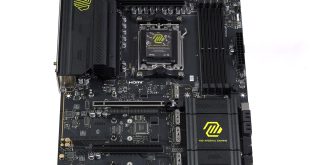Starting at the front, the panel is easily removed by pressing the markings and reveals a large dust filter in front of two 140 mm fans. These are based on Corsair's excellent AF140 fans.
Moving from the bottom to the top, we can see the removable dust filter under the power supply and two modular drive cages.
These are held in place with two screws and can be stacked to create space for a 280 mm radiator at the front, stacked under the 5.25″ drive bays to facilitate a 280 mm radiator in the bottom of the case or stacked at the front of the case to allow for a bottom in-take fan.
If both cages are stacked under the 5.25″ drive bays users can also opt to mount two 120 mm fans in the bottom of the case.
There are 5 large rubber grommets to aid with cable management and a large CPU cut-out to install a cooler whilst the motherboard is in the case. Anyone who has ever lost a screw in the process of building a PC can rest easy knowing the stand-offs have been pressed into the tray.
In the top left corner we can see the third 140 mm fan included with the case. Above this fan is enough space to fit either three 120 mm fans or two 140 mm fans. Water cooling enthusiasts will be happy to know they can fit a 360 mm radiator in the top, though this will block the top 5.25″ drive bay.
Along the right side, behind the drive cages and 5.25″ drive bays are 4 caddies for solid state drives.
A different angle shows how the caddies are held in place by clips on one side and slide into cut-outs on the other side.
Corsair uses a push mechanism to hold 5.25″ drives in place. Although made of plastic, there is no sign of cutting corners.
The large window makes cable management an even more important feature than it already is on a high-end case. Corsair provide plenty of options to route cables behind the motherboard tray and the large rubber grommets offer enough space to route a variety of cables.
The bundle of front panel connectors is neatly tucked away behind the 5.25″ drive cage and can be routed behind the second drive cage in the bottom or directly below the motherboard through one of the available rubber grommets. Three additional cut-outs are also available above the motherboard to help builders hide, for example, fan cables.
The large cut-out, combined with the available space in the roof of the case means even large CPU coolers can be installed without removing the motherboard.

We moved one of the drive cages to show the modular design of the Obsidian 750D. Whilst suspended the cage sits out further than the cage in the bottom of the case. However, Corsair have clearly taken this into consideration as the panel slides back on without a problem.
Solid state drives and other 2.5″ drives slide into one of the 2.5″ caddies and are held in place by a latch, removing the need for any screws.


A common method to hold 3.5″ drives in place is used for the remaining caddies. Bending the plastic allows for the drive to be lined up with the pre-installed pins, at which point they will snap in place. Alternatively, mounting holes for 2.5″ drives are available.
As is to be expected with a full tower case, our hardware fits without any issues. We used some blue cable ties to highlight where we secured our cables.
As we were curious to find out how forgiving the Obsidian 750D is, we chose to stack a number of cables and we can happily report that the panel did not bulge after we closed the case.
For this final shot we also moved one of the drive cages once more to further highlight the modular design.

Finally, the above image shows just how much space is available in the top section of the Obsidian 750D, even with our Phanteks PH-TC14PE cooler in place. Although we did not have one on hand, it is clear to see water cooling enthusiasts can fit a 360 mm radiator and maintain a clean look throughout.
 KitGuru KitGuru.net – Tech News | Hardware News | Hardware Reviews | IOS | Mobile | Gaming | Graphics Cards
KitGuru KitGuru.net – Tech News | Hardware News | Hardware Reviews | IOS | Mobile | Gaming | Graphics Cards













wow thats a really good price for such a nicely built chassis, was expecting around £50 more considering. GJ Corsair
thats good pricing indeed. They make nice looking cases. I love my carbide